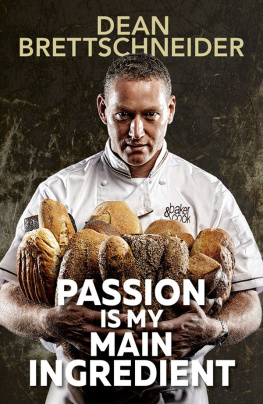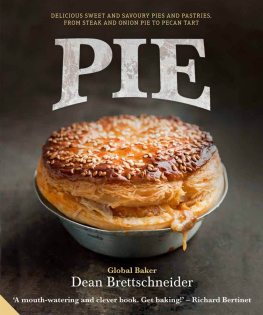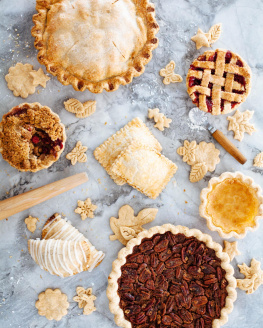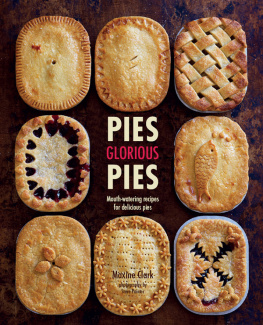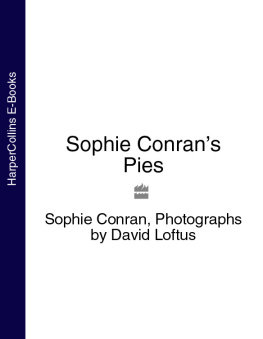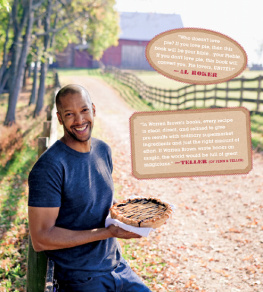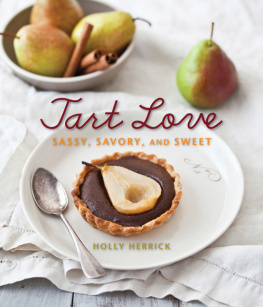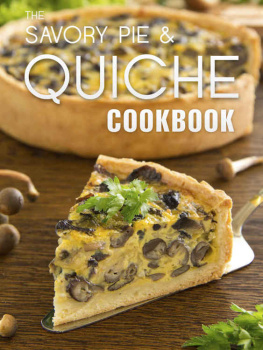Dean Brettschneider is a professional baker, ptissier and entrepreneur. Arguably one of the worlds best bakers, Dean is truly a global baker. He was based in Shanghai for several years and now resides in Denmark and New Zealand, where he heads up his global baking empire, and travels regularly to the United Kingdom where he is a consultant. Dean is also the founder and co-owner of the global bakery chain Baker & Cook, which has its flagship store in Singapore (www.bakerandcook.biz). Dean is the author of several award-winning books on baking, and is involved in a number of television programmes that promote baking excellence.
www.globalbaker.com
PIE
80+ PIES AND PASTRY DELIGHTS
Global Baker
Dean Brettschneider
Photography by Aaron McLean

First published in the UK in 2013 by:
Jacqui Small LLP
An imprint of Aurum Press
74-77 White Lion Street
London N1 9PF
First published by Penguin Group (NZ), 2012
Copyright Dean Brettschneider, 2012
Copyright photography Aaron McLean, 2012
The right of Dean Brettschneider to be identified as the author of this work in terms of section 96 of the Copyright Act 1994 is hereby asserted.
No part of this publication may be reproduced, stored in a retrieval system, or transmitted, in any form, or by any means, electrical, mechanical, photocopying, recording or otherwise without the prior written permission of the publisher.
ISBN: 9781909342668
A catalogue record for this publication is available from the British Library.
E-book conversion by Quayside/Code Mantra
Contents
Introduction
Like most New Zealanders, I grew up with pies for lunch from the high school tuck shop. I remember that lukewarm, runny minced beef and gravy-like filling encased in a soggy, under-baked, doughy pastry wrapped in a cellophane-sealed bag that was kept in a pie warmer (or heated from frozen in a pie warmer set at 60C, which is the holding temperature, not the heating temperature!). Sometimes it was still frozen in the middle and usually squashed. Thank goodness for tomato sauce, which we squirted all over it to make it edible!
Another childhood memory is of Mum buying a family pie from the supermarket. What a treat it was, unbaked in a large aluminium foil the size of a dinner plate. If I remember correctly, it was called a Mince Family Plate Pie. We would heat the oven up, brush the pie with milk (there was no mention of egg wash) to get a glaze, shove it in the oven, bake it until it looked brown and then serve it with mashed potatoes and boiled minted peas.
Then along came the microwave pie funnily enough, in my early days of product development for a national industrial pie maker, I was involved in the science behind making pastry crispy in the microwave. Lets just say thank goodness times have moved on to a point where quality really does matter.
There is nothing more satisfying than eating a piping hot, freshly baked pie, tart, quiche or even sausage roll, out of the kitchen oven, brimming with various fillings enclosed in a buttery pastry. Or one left to cool down slightly and eaten warm, or allowed to fully cool before being decorated with pastry cream, fresh cream, fruits, nuts, dusted with icing sugar or even glazed with an apricot glaze to take it from ordinary to extraordinary.
Pies in many shapes and sizes are made around the globe and are the most-baked product in the home kitchen the world is full of home bakers making their favourite pies for themselves, families and friends.
Traditional pies, which have been handed down in grandmothers old recipe books, are popular again. Then there are the new versions with modern twists on the classics, using newly available ingredients and flavour combinations to wake up the taste buds. Pies are even now becoming part of the menu in fine-dining restaurants. The humble pie is coming back with passion.
The pies, tarts, pastries and the not-quite-a-pie pies in this book are mostly based on traditional recipes but have been given that familiar twist, either to the filling combinations or the pastry, that I am known for in my global, new world baking style.
How to use this book
In the following chapters, and in the Basic Recipes at the back of the book, I take time to unlock quite a few basics on the making and baking of pastry. I cant stress enough that, in order for you to succeed, you need to take the time to read all about the ingredients, the equipment and, most importantly, the basic processes and techniques necessary to make pastries and pies. I would even go so far as to suggest that you keep the book beside your bed for your night-time reading.
Sweet, short and puff pastry are all used in this book some basic and some innovative, with many flavour twists and combinations. Once the basics are mastered, dont be scared to mix and match the pastries to suit yourself nothing is set in stone.
When making any of the pastries, I recommend you double or triple the recipe and divide it into smaller batches. Wrap each portion of pastry in plastic wrap and place in the freezer until needed, then just remove from the freezer, thaw and use as described in the recipe. Pastry freezes exceptionally well, so make life easy and think ahead.
And as for the question everyone wants to ask me can you use store-bought pastry? The answer is yes, of course, its your choice but also its all part of the experience to make your own!
Happy pie making and baking. Global Baker Dean Brettschneider www.globalbaker.com

The History of the Humble Pie
The Pie in History
Firstly the question should be asked: what is a pie? The Oxford Dictionary describes it as: A baked food consisting of one or two layers or crusts of pastry with a filling.
Its interesting to note that the first recorded use of the word pie relating to food was as far back as 1303, and by 1362 the pie was well known and popular as a food medium. But when was the first pie reputed to have been made? Lets take a brief journey back in time.
The pie can be traced back in history to the ancient Egyptians. They were prepared and baked by the Pharaohs bakers, who encased fillings in bread dough which was considered a primitive form of pastry dough. These early pies consisted of fillings based on field plants and grains and, if sweetening was required, honey was the key, sought-after ingredient. Even the pie then was considered a delicacy.
Its widely understood that the Greeks were the first makers of pie pastry as such. It was prepared by forming flour and water into a very simple dough, which was in turn wrapped around well-seasoned meats. This pastry encasement served to retain the baking juices within and around the meat fillings. However, this pastry casing was not always intended to be eaten; it served to contain the filling and its varying flavour releases during the baking process.


